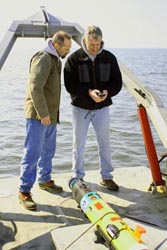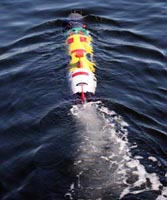Marine Scientists Marry a Robot and a Hydrophone to Track Fish

Over the years, Ken Able and Thomas Grothues have tagged and tracked hundreds of striped bass and flounder passing through the Little Egg Inlet and traveling around Great Bay and Barnegat Bay.
“The common way to track fish has been to tag them individually with transponders and then track them with a hydrophone. Alternatively, we would regularly visit a grid of locations to see if the fish we tagged were there or not,” said Grothues, an assistant research professor of marine science.
So, Grothues and Able, based at the Rutgers University Marine Field Station in Little Egg Harbor Township, are trying to blend two separate technologies to create a more efficient and cost-effective solution that combines the hydrophone with new breed of submersible vehicle.
The vehicle is one of the latest remote environmental monitoring units, commonly called REMUS, built by Hydroid, LLC of Pocasset, Massachusetts. Unlike Rutgers’ submersible robot gliders, which slowly propel themselves by changing buoyancy, the REMUS has an electric motor that drives it straight ahead at up to four knots. It has side-scan sonar that provides a picture of the bottom and sensors to measure the temperature, salinity, and turbidity of the water over a wide area.

The hydrophone, produced by Lotek Wireless, Inc., of Newmarket, Ontario, contains a sophisticated computer capable of identifying many transponder tags at once, even in noisy conditions – a task akin to following the conversations of a crowd in a room where everyone is speaking different languages.
By measuring the difference in the arrival times of tag transmissions at the moving REMUS, the hydrophone can determine the location of the fish to within meters and match it with information from other sensors that the REMUS carries. The first planned use of this new tool is monitoring the dispersal and survival of flounder “by catch” – that is, the fish caught unintentionally – released from a commercial trawler late this summer.
This work is being funded by the National Undersea Research Program.